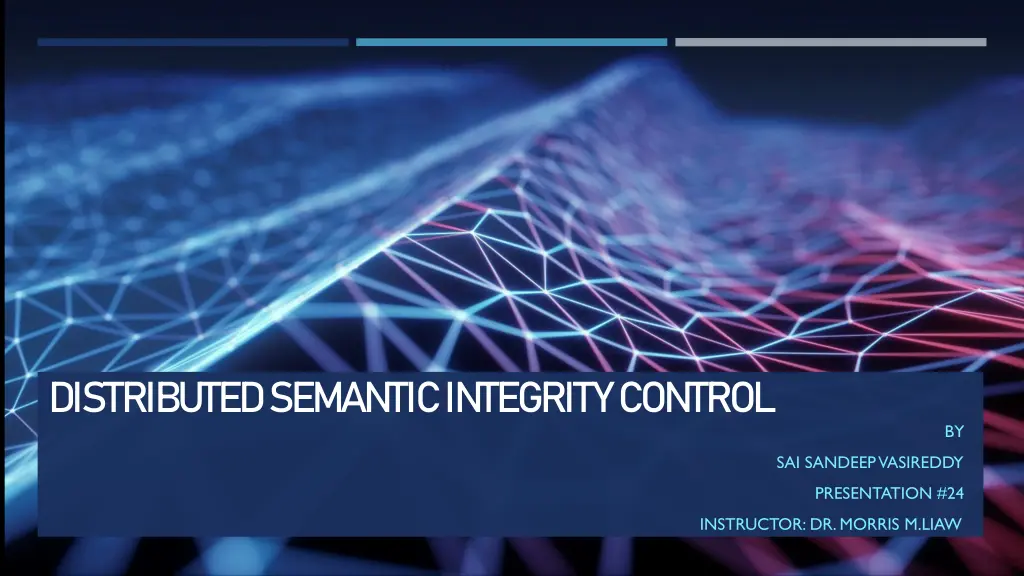
Distributed Semantic Integrity Control Strategies
Learn about distributed semantic integrity control strategies by Sai Sandeep Vasireddy with a taxonomy of integrity assertions, including individual, set-oriented, and aggregate assertions. Explore compatibility checks, considerations for horizontally fragmented relations, and set-oriented assertion cases.
Download Presentation

Please find below an Image/Link to download the presentation.
The content on the website is provided AS IS for your information and personal use only. It may not be sold, licensed, or shared on other websites without obtaining consent from the author. If you encounter any issues during the download, it is possible that the publisher has removed the file from their server.
You are allowed to download the files provided on this website for personal or commercial use, subject to the condition that they are used lawfully. All files are the property of their respective owners.
The content on the website is provided AS IS for your information and personal use only. It may not be sold, licensed, or shared on other websites without obtaining consent from the author.
E N D
Presentation Transcript
DISTRIBUTED SEMANTIC INTEGRITY CONTROL BY SAI SANDEEP VASIREDDY PRESENTATION #24 INSTRUCTOR: DR. MORRIS M.LIAW
DISTRIBUTED SEMANTIC INTEGRITY CONTROL Definition: An integrity assertion is supposed to be expressed in tuple relational calculus. There is a strategy based on a taxonomy of integrity assertions that distinguishes 3 classes of assertions: Individual assertion:They refer only to tuples to be updated independently to the rest of the database. i. Set-oriented assertion: It includes single-relation multi variable constrains such as functional dependency ii. and multi-relation multi-variable constrains such as foreign key constrains. Assertion involving aggregates: It requires special processing because of the cost of evaluating the iii. aggregates.
INDIVIDUAL ASSERTION The assertion must be compatible with the relation data at each site. Compatibility can be checked at two levels: predicate and data. Predicate compatibility is verified by comparing the assertion predicate with the fragment predicate. The compatibility checks are performed only for compiled assertion whose update type is INSERT .
Consider relation EMP, horizontally fragmented across 3 sites using predicates And the domain assertion C: Assertion C is compatible with P1 If C is true and P1 is true. P2 If C is true and P2 is not necessarily false. P3 If C is true then P3 is always false. Therefore, assertion C should be globally rejected because the tuples at site 3 cannot satisfy C, and thus relation EMP does not satisfy C.
SET ORIENTED ASSERTION They are multivariable; that is, they involve join predicates. The assertion predicates may be multi-relation, a compiled assertion is associated with a single relation. Therefore, the assertion definition can be sent to all sites that store a fragment referenced by these variables.
Let us consider set-oriented assertion in (ASG, INSERT, C1) where C1 is Let us consider 3 following cases: 1. ASG is fragmented using the predicate where PROJ i is a fragment of relation PROJ.
2. PROJ is horizontally fragmented based on 2 predicates In this case tuple NEW of ASG is compared with either fragment PROJ1 , if NEW.PNO < J3 or fragment PROJ2 if NEW.PNO >= j3 . 3. PROJ is horizontally fragmented based on 2 predicates In this case each tuple of ASG must be compared with both fragments PROJ1 and PROJ2.
CONCLUSION Semantic data and access control includes view management, security control, and semantic integrity control. Full semantic data control is more complex and costly in terms of performance in distributed systems. Thus the specification of distributed data control must be included in the distributed database design so that the cost of control for update programs is also considered.
